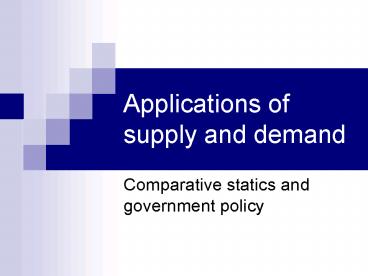Applications of supply and demand - PowerPoint PPT Presentation
Title:
Applications of supply and demand
Description:
Title: Economics 1 Author: Economics Department Last modified by: uvic Created Date: 9/20/2004 8:08:28 PM Document presentation format: On-screen Show – PowerPoint PPT presentation
Number of Views:35
Avg rating:3.0/5.0
Title: Applications of supply and demand
1
Applications of supply and demand
- Comparative statics and government policy
2
Comparative statics
- The simple supply and demand model we have
developed can be used to analyze the effects of
many events on a market - Here, we will start by analyzing the impacts of
changes in supply and demand while holding other
factors fixed - We will then use the model to examine how
government policy influences outcomes in the
market
3
Shifts of the demand curve
- Example
- Beer and pizza are complements
S
- Suppose the price of beer falls.
E1
P1
D1
Q1
4
Shifts of the supply curve
- Example
- Market for apples
S1
- Suppose the price of wine increases
E1
P1
D1
Q1
5
Simultaneous shifts
- What if both demand and supply shift?
- Example
- Market for scalped tickets
S1
E2
- An unexpected addition to the concert
P1
E1
- In this example big decrease in supply and a
small increase in demand
D1
Q1
6
Shifts in the opposite direction
- When supply and demand shift in opposite
directions we can predict what happens to price
but not quantity - When demand increases and supply decreases
- When demand decreases and supply increases
7
Shifts in the same direction
- When supply and demand shift in the same
direction we can predict what happens to quantity
but not price - When both demand and supply increase
- When demand and supply decrease
8
Government policy
- Government sometimes attempts alternative
rationing mechanisms - Usually on the grounds of moral fairness
- Three mechanisms we will study are
- Price Ceilings/Floors
- Taxes
- Quotas
9
Price ceiling
- Suppose a price ceiling is introduced below the
equilibrium price. - Example rent control
S
- This causes
PE
E
D
QE
10
Price floor
- Suppose a price floor is introduced above the
equilibrium price. - Example minimum wage
S
- This causes
PE
E
D
QE
11
Equilibrium and efficiency
- The demand curve tells you
- At any given price, what is the quantity
demanded? - But it also tells you
- Similarly, the supply curve tells you
- At any given price, what is the quantity
supplied? - But it also tells you
12
Equilibrium and efficiency
- If the market is not in equilibrium, it is
inefficient. - Inefficient means some person could be made
better off without making other people worse off.
P
S
surplus
PE
E
- Example price floor
- But the price floor prevents that trade (it would
take place below the price floor).
D
Q
QE
QEF
13
Taxes
- We will study excise taxes
- An excise tax is a tax of a certain dollar amount
on each unit bought or sold - This can be imposed either on producers or on
consumers (the legal incidence of the tax) - Tax on Producer
- Tax on Consumer
14
An excise tax on producers
- An excise tax on producers of T per unit shifts
the supply curve up.
P
S1
PE
E
D
Q
QE
15
An excise tax on consumers
- An excise tax on consumers of T per unit shifts
the demand curve down.
P
S
PE
E
D1
Q
QE
16
Economic incidence of a tax
- In our two examples, if we assume that the amount
of the tax (T) is the same, the results are
exactly the same - How exactly the tax is split up between consumers
and producers we will look at in the next topic.
17
Taxes and efficiency
- Taxes create inefficiency
- At least one consumer could be made better off
without making others worse off. - But the tax prevents that trade (not the whole
tax T would be paid).
P
S1
PC
PE
E
T
PP
D
Q
QE
QT
18
Quotas
- A quota simply limits the quantity of a good
sold. - Achieved by selling quota licenses.
P
S
PE
E
D
Q
QE
Q
19
Supply and demand and welfare
- A story about happiness in dollars consumer and
producer surplus
20
Consumer surplus
- The demand curve shows the willingness to pay for
each unit of the good. - The consumer who buys the first unit of the good
would have been willing to pay P1 but only has to
pay PE.
P
S
P1
PE
E
D
Q
QE
21
Changes in consumer surplus
- Suppose the equilibrium price falls.
- (Maybe because of an increase in supply.)
- Consumer surplus increases for two reasons
P
S1
P1
E1
E2
D
Q
Q1
22
Producer surplus
- The supply curve shows the minimum cost for each
unit of the good. - The producer who sells the first unit of the good
would have been willing to sell for P1 but
actually gets PE.
P
S
PE
E
D
P1
Q
QE
23
Changes in producer surplus
- Suppose the equilibrium price rises.
- (Maybe because of an increase in demand.)
- Producer surplus increases for two reasons
P
S
E2
P1
E1
D1
Q
Q1
24
Total surplus
- Total surplus is the sum of (total) consumer
surplus and (total) producer surplus.
P
S
PE
E
D
Q
QE
25
Taxes and efficiency
- Taxes create inefficiency (a loss of total
surplus).
P
S
- Available to society
- Consumer surplus
- Producer surplus
- Tax revenue (QT T)
PC
PE
E
T
PP
D
- Lost to society
QT
Q
QE































